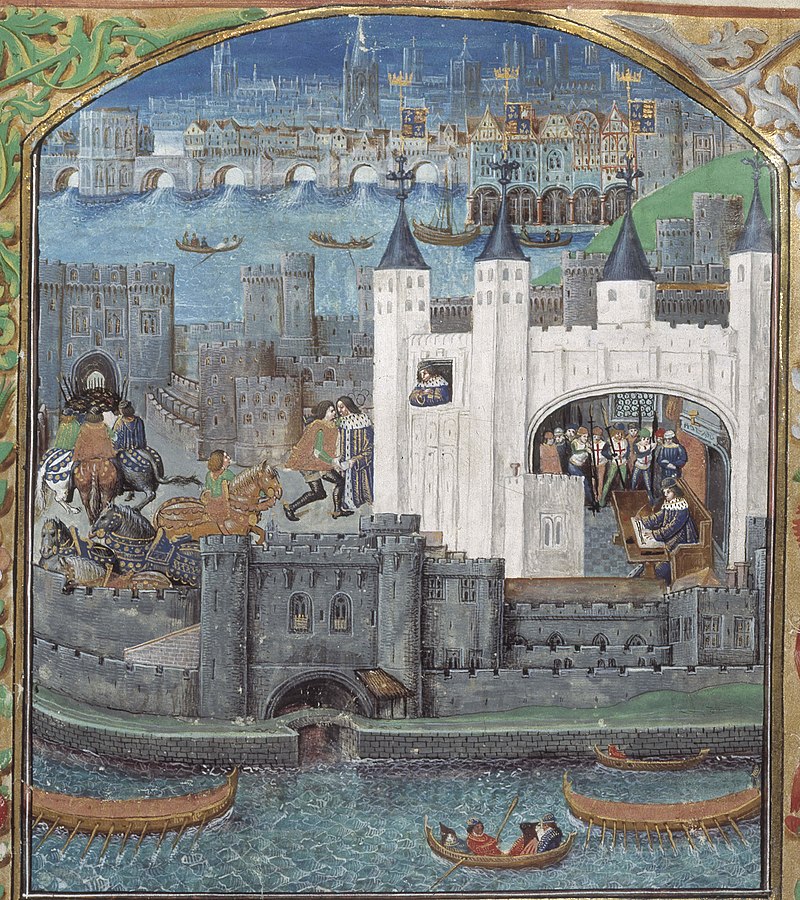by Susan Flantzer
© Unofficial Royalty 2021

Chapel of St. John the Evangelist; Credit – Par Bernard Gagnon — Travail personnel, CC BY-SA 3.0, https://commons.wikimedia.org/w/index.php?curid=3675338
View the short video linked below to see a brief tour of the Chapel of St. John the Evangelist.
The Chapel of St. John the Evangelist, which this writer has visited, is located in the White Tower at the Tower of London in London, England. Originally a Roman Catholic chapel, it is a Church of England chapel (also known as Anglican and in the United States, Episcopal). The Chapel of St. John the Evangelist is a royal peculiar which means it is under the direct jurisdiction of the British monarch. It is also a chapel royal, an establishment in the royal household serving the spiritual needs of the British monarch. However, members of the royal family rarely attend services there but services continue to be held periodically. King Charles III received communion at the chapel on his twenty-first birthday.

The White Tower; Credit – By Bernard Gagnon – Own work, CC BY-SA 3.0, https://commons.wikimedia.org/w/index.php?curid=3675330
The building of the White Tower (1077 – 1097) began in the reign of King William I (the Conqueror), the first monarch of the House of Normandy, and continued into the reign of his son King William II Rufus. The White Tower is the central tower of the Tower of London. It was the Tower of London’s strongest point militarily and also provided residential and ceremonial apartments for the king and his family. The Chapel of St. John the Evangelist, constructed with Caen stone imported from Normandy, was built in the Norman architecture style, Romanesque architecture developed by the Normans in the lands under their rule during the eleventh and twelfth centuries.

A 15th-century depiction of the Tower of London and its keep, the White Tower; Credit – Wikipedia
The Chapel of St. John the Evangelist dates from 1080 and was used by the royal family while in residence at the Tower of London. By the reign of King Charles II (1660 – 1685), the Tower of London was barely used as a royal residence and the Chapel of St. John the Evangelist became a storeroom for state documents. In 1857, the documents were removed to the new Public Records Office, and the Chapel of St. John the Evangelist was restored to its original splendor.

Tower of London with the White Tower in the middle; Credit – By [Duncan] from Nottingham, UK – Tower of London from the Shard, CC BY 2.0, https://commons.wikimedia.org/w/index.php?curid=32007084
- During the Peasants Revolt of 1381, early in the reign of King Richard II, Simon Sudbury, Archbishop of Canterbury and Chancellor of England took refuge in the Chapel of St. John the Evangelist from an angry mob who had broken into the Tower of London along with Sir Robert Hales, Lord High Treasurer, William Appleton, the physician of John of Gaunt (a son of King Edward III), and John Legge, a royal sergeant. All four men were dragged from the chapel and taken to nearby Tower Hill where they were beheaded by the rebels.
- Starting with the coronation of King Henry IV in 1399, the Knights of the Bath held all-night vigils in the Chapel of St. John the Evangelist, on the eves of coronations. This ceremony continued to be held in the Chapel of St. John the Evangelist until the coronation of Elizabeth I in 1559, when it was moved to the Chapel of St. Peter ad Vincula, also at the Tower of London.
- In 1503, Elizabeth of York, wife of King Henry VII, died from childbirth complications at the Tower of London, most likely in the White Tower, after the birth of her last child who also died. After her death, the remains of Elizabeth of York temporarily rested in the Chapel of St. John the Evangelist.
- In 1674, during the reign of King Charles II, workers doing some remodeling in the White Tower dug up a wooden box containing two small human skeletons. The bones were found buried ten feet under the staircase leading to the Chapel of St. John the Evangelist. Presuming the remains were those of King Edward V and Richard, Duke of York, the young sons of King Edward IV, known as the Princes in the Tower, who went missing in 1483, King Charles II ordered the remains placed in an urn in Westminster Abbey. In 1933, the remains were removed from the urn and examined. The conclusion was that the bones belonged to two children around the correct ages for the princes. This examination has been criticized with one of the issues being no attempt was made to determine if the remains were male or female. There has been no further examination and the remains are still in the urn in Westminster Abbey.
This article is the intellectual property of Unofficial Royalty and is NOT TO BE COPIED, EDITED, OR POSTED IN ANY FORM ON ANOTHER WEBSITE under any circumstances. It is permissible to use a link that directs to Unofficial Royalty.
Works Cited
- Borman, Tracy, 2015. The Story of The Tower of London. London: Merrell Publishers Limited and Historical Royal Palaces.
- Camelotintl.com. 2021. Camelot International: Tower of London. [online] Available at: <http://www.camelotintl.com/tower_site/tower/white_frame.html> [Accessed 26 February 2021].
- Chapels Royal, H., 2021. Chapels Royal, H M Tower of London | The Chapel of St John the Evangelist. [online] Thechapelsroyalhmtoweroflondon.org.uk. Available at: <https://www.thechapelsroyalhmtoweroflondon.org.uk/welcome/the-chapel-of-st-john-the-evangelist/> [Accessed 26 February 2021].
- En.wikipedia.org. 2021. St John’s Chapel, London. [online] Available at: <https://en.wikipedia.org/wiki/St_John%27s_Chapel,_London> [Accessed 26 February 2021].
- En.wikipedia.org. 2021. Tower of London. [online] Available at: <https://en.wikipedia.org/wiki/Tower_of_London> [Accessed 26 February 2021].
- En.wikipedia.org. 2021. White Tower (Tower of London). [online] Available at: <https://en.wikipedia.org/wiki/White_Tower_(Tower_of_London)> [Accessed 26 February 2021].
- Englishmonarchs.co.uk. 2021. The Chapel of St. John, White Tower .. [online] Available at: <http://www.englishmonarchs.co.uk/tower_london_17.html> [Accessed 26 February 2021].
- Thurley, Simon, Impey, Edward and Hammond, Peter, 2005. The Tower of London – The Official Guidebook. London: Historical Royal Palaces.
